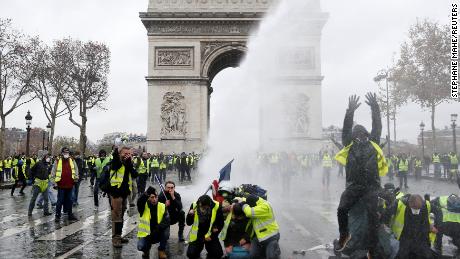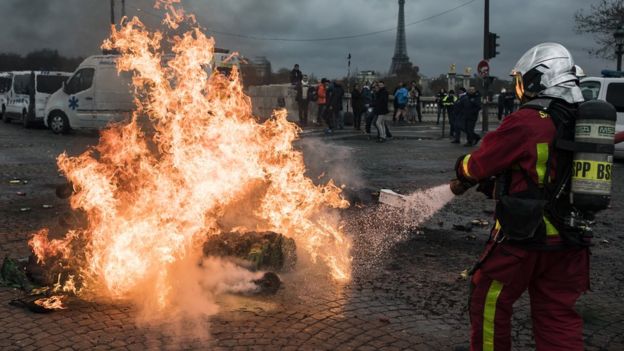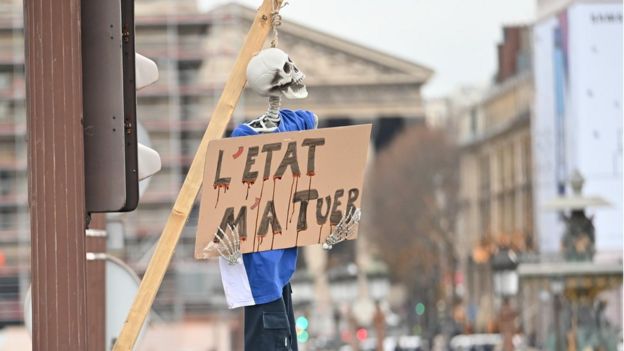Protesting the Entitlements of Elitism
"Ask a Parisian -- for him none of this is an issue, because he doesn't need a car."
"We live on the side of a mountain. There's no bus or train to take us anywhere. We have to have a car."
Marco Pavan, 55, former truck, taxi driver, Besancon, France
"In these territories marked by the absence of a tomorrow, there's a form of post-industrial despair that's now gnawing at the middle and working classes who suffered the brunt of the brutal [global economic] crisis in 2008 and the ensuing budget cuts."
"To give one example, a young student who just finished her bachelors told me that she couldn't stay in her home region because, in her city, 'there is nothing'."
Niels Planel, poverty reduction consultant, Paris
 | |
| Getty Images |
The protests, which began in early November have become increasingly raucous and violent. President Emmanuel Macron who had sneered and protested at U.S. President Donald Trump sending the American military to the border with Mexico to prevent the illegal entry of economic migrants from Central America over the border into the United States, using tear gas to dissuade border rioters now uses the same methods on French citizens. Three people have so far died since the protests began, while hundreds have been imprisoned and injured.
Protesters in Paris marched down the Champs-Elysees while hurling projectiles at police and for their troubles being tear-gassed. This is the most serious violence the capital has seen in a half-century. On Sunday, Paris police announced 412 arrests and 133 people were injured as the streets of the capital were trashed in a demonstration protesting rising taxes and the high cost of living. The landscape simmers with broken windows, charred cars and the litter that disgraces the city's most iconic tourist areas.
 |
| Private ambulance drivers protested against reforms to the healthcare system Getty Images |
During the first of the countrywide demonstrations, about 300,000 people participated. A week later 106,000 protesters came out, increased last Saturday to 136,000 involved in the protests. That's not millions, but it is a lot of people angry enough to lend themselves to a vocal rejection of government initiatives that they see as harming them economically at a time when full recovery from the financial downturn of 2008 has not arrived.
Private ambulance drivers staged their own demonstrations, highlighting for their part, a full range of social security and health care reforms that they claim will impact deleteriously on their services and by extension, the public that relies upon them. "[The reforms] will bludgeon us financially and destroy our companies. We're going to have to fire people, that's for sure", prophesied one of the protesters at the ambulance drivers' gathering.
 |
| Changes affecting ambulance drivers are part of a raft of reforms by President Macron Getty Images |
Most of the protesters outside Paris feel President Macron represents an elite coterie that has no understanding of, nor interest in how others live, let alone the decline of traditional industry that has eviscerated their city, limiting their prospects for the future. "And then there's the disdain -- he openly mocks people", Yves Rollet, 67, a Besancon retiree exclaimed, a yellow vest visible in his parked car. He had, he said, taken part in last weekend's protest since he was completely disgusted with the way the Macron government has become monarchical, dismissive of poor and working people.
Macron has stood out as one of the world's leading advocates for action designed to fight climate change. His unsuccessful efforts to bring American President Donald Trump around to his way of thinking and to convince him to remain within the 2015 Paris Climate Accords has distinguished his commitment to action, saving the world from controversial climate change eventuality. Traditionally French vehicle owners have depended more than any other European country on diesel cars. Raising taxes on diesel is one of the signal elements of the global climate guidelines.
:no_upscale()/cdn.vox-cdn.com/uploads/chorus_asset/file/13598572/GettyImages_1067260248.jpg) |
Macron's government has committed the country to banning future sales of all gasoline-powered cars by 2040 -- even while Paris and surrounding suburbs are moving to ban older-model diesel cars from their roads. Opponents of the government from both the far-left and the far-right are in full support of the yellow vest movement; their involvement allowing government to consier the protests as politically motivated, a temporary spectacle.
/cdn.vox-cdn.com/uploads/chorus_image/image/62617576/GettyImages_1067259954.0.jpg) |
Labels: Austerity, Climate Change, Fossil Fuels, France, Protests

<< Home